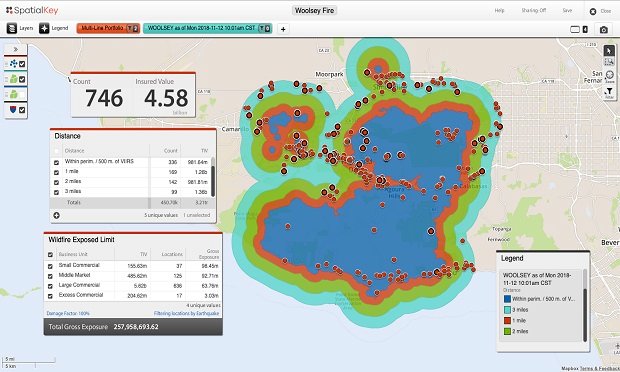 Many of the best technology tools that haveimproved performance among insurance carriers have multiple layersof productivity and nowhere is that more evident than in the use ofpredictive modeling and analytics. Today, not only are modelsassisting insurers in their ability to predict outcomes, theanalytical tools are also helping carriers prevent greater lossesin areas ranging from workers' compensation to catastrophes.
Many of the best technology tools that haveimproved performance among insurance carriers have multiple layersof productivity and nowhere is that more evident than in the use ofpredictive modeling and analytics. Today, not only are modelsassisting insurers in their ability to predict outcomes, theanalytical tools are also helping carriers prevent greater lossesin areas ranging from workers' compensation to catastrophes.
As one analyst sees it, the use of predictive modeling andanalytics allows carriers to “up their game,” according to BillJenkins, a consultant with Agile Insurance Analytics. Modelingenables insurers to not just compete with others in their market,but to grow their business as well, adds Jenkins. The bad news,though, is most insurance carriers still have a long way to go toattain the real value that this technology presents to theindustry.
|“[Analytics] has made insurance a much more competitive market,”says Jenkins. “Some of what I call Stage 5 carriers—Progressive,Allstate, and other big carriers—are jumping into analytics withboth feet and are using the tools to get more focus around thelong-term value of the customer. They are using modeling to furtherdifferentiate themselves.”
|Prevention the Key
|Insurance companies traditionally focused their predictivemodeling on the underwriting field because it was easier to developmodels that predicted potential losses of policyholders. It was astraight-forward process, explains Marina Ashiotou, director ofpredictive modeling, Accident Fund Holdings, Inc.
|
Carriers used that information to determine a fair premium tocharge a customer that also would enable the insurer to beprofitable. The insurer would look at a renewal or whether to writea new piece of business and base their decisions on the models thathad been developed.
|Carriers have begun to look at prevention of incidents as yetanother way to develop the models and improve profitability.
|“When you look at prevention, the models are different,” saysAshiotou. “It's not just about the policyholder. The informationthat you need to use to do your modeling becomes more granularbecause now [in a workers' compensation policy] you care about theemployees, how skilled they are, their age, characteristics, andthe location the business is operating in.”
|The information is different from what has been used forunderwriting a policy, explains Ashiotou.
|One area many insurers have been using data characteristics iswith fraud. Success there can make a positive impact on expenseratios, according to Jenkins.
|“Carriers are using characteristics or variables aroundprojecting expenses as they relate to claims as well as claimsseverity and frequency,” says Jenkins.
| Loss expenses are being analyzed and insurersare seeking independent variables around the account informationthe carrier has on their policyholders.
Loss expenses are being analyzed and insurersare seeking independent variables around the account informationthe carrier has on their policyholders.
“Carriers are getting a better feel around what kind ofinvestigation needs to take place,” says Jenkins. “Analytics havebeen used for years around reasonable and customary costs forclaims adjudication. Carriers are looking to refine that evenfurther and push through models with more granular information onthe policyholder, claims history, and policy history.”
|Karen Pauli, research director at CEB TowerGroup, also believesprevention is changing the way carriers conduct predictivemodeling. Prevention requires an expanded use of external data ordata from non-traditional sources.
|“There are some great third-party data providers—LexisNexis,Axion, TransUnion,” says Pauli. “These are companies with greatdata. Tools such as telematics also give insurers great data. Thereare things insurance underwriters and modelers and actuarieswouldn't know without that data.”
|Another advantage modelers have is what Pauli calls therelational social types of data. For instance, SAS Institute hasdata on fraud where they add the relational data so insurers candetermine the fraud range, adds Pauli.
|“You couldn't do that as an underwriter or a claims person,” shesays. “It's great data and it is changing outcomes, particularlycutting off a claim before you pay [too much]. External datadefinitely is helping.”
|One challenging piece of information that companies are lookingfor in claims predictive modeling, and the prevention of incidentsis text analytics, which refers to the process of derivinghigh-quality information from text. This information is usuallyderived through devising patterns and trends.
|“Carriers have discovered in the notes turned in by their claimsadjusters that there is so much relevant information that has notbeen captured in any other way,” says Ashiotou. “There is a move totry and systemize that information so it can be used inmodeling.”
|Carriers have been unable to perform this type of modeling inthe past because the data wasn't ready to perform this kind ofwork, according to Ashiotou.
|“With models for underwriting, nearly anyone can pull the datafrom fancy policy systems,” she says. “But when you are usingmodels for prevention companies don't necessarily have the dataavailable to do any sort of analytics or modeling.”
|Ashiotou points out that in other lines of insurance,particularly life insurance, there are similar problems involvingprevention.
|“There is no data available there to do real predictivemodeling,” she says. “What companies find themselves doing in thatspace is spending five years or so to get their data in shape to dothe analytical work. Not a lot of [life insurance] companies havedone text analytics because it is challenging and not thepush-of-a-button type of solution where someone can supply you withthe software and say now you can do text analytics. This issomething you need to work on quite a bit before it can becomeuseful.”
|IT Involvement
|Jenkins maintains the business rules used in modeling should bethe province of the user community.
|“[Business users] have to define what earned premium is and whatclaims count means,” he says. “IT can't do that.”
|Jenkins recently met with a group of insurers and the discussionled to who had the responsibility of maintaining the businessrules. Jenkins was disappointed when he learned one carrier didn'thave a data governance policy in place.
|“They planned to sit down as a group to do that, but I cautionedthat they were going to have problems,” he says. “It really getsdown to a data governance process that is required. The businessrules generally are put into place by the users, but they can berefined as things go forward and as companies utilize predictiveanalytics and see the outcomes, things like live data andthird-party data, and the rules around them get adjusted.”
| Pauli maintains that throwing more information at alreadycomplex claims or underwriting processes is not always helpful,which is where predictive analytics and models come in. Carriersneed to have the analytics available to pick out the predictivedata, put it into a model, model the predictive outcome, and thento be able to automate that model to scores, straight-throughprocessing, decisioning or decision support.
Pauli maintains that throwing more information at alreadycomplex claims or underwriting processes is not always helpful,which is where predictive analytics and models come in. Carriersneed to have the analytics available to pick out the predictivedata, put it into a model, model the predictive outcome, and thento be able to automate that model to scores, straight-throughprocessing, decisioning or decision support.
“You can model the decision and the underwriter or claims personlooks at the model and then uses their experience to decide whatthat information suggests,” says Pauli.
|While much of the industry has been focusing on refreshinglegacy systems, Jenkins believes these carriers have been ignoringthe data piece of the business.
|“That's a shame,” says Jenkins. “Data is a differentiator with acompany. [Insurers] have their own history with customers and haveexperience from a service standpoint and an account standpoint, butthey are not using that data as well as they should.”
|Applying Rules
|One area of uncertainty concerning modeling deals with whichside of the operation should handle implementation of the businessrules surrounding the models. Pauli concedes having the businessside perform the work would take the burden off IT, but she pointsout that it would be a change in culture.
|“IT is used to doing certain things while actuaries are used toworking with models and handing an outcome to underwriting andclaims folks,” she says. “You have to look at the scarcity ofresources that are competent and proficient in things likeanalytics and models. The number of business analysts that havethose capabilities are needed to adopt certain technologies toenable the business side to interact with the models.”
|Pauli believes there is a great advantage inletting a business person interact with the models and let thebusiness person perform “what-if” scenarios. She adds that theultimate goal for an actuary, a modeler or a mathematician would beto understand nuances, so they can interact with the model.
| “Maybe they even break the model—push the data to thepoint where the model is not working anymore,” she says. “That waythey are finding out what they shouldn't be doing. That's valuableto a business person. It wouldn't be valuable to a modeler or anactuary because they are trying to hit a goal. We said all lastyear and now in 2013: The business side needs to interact with themodels.”
“Maybe they even break the model—push the data to thepoint where the model is not working anymore,” she says. “That waythey are finding out what they shouldn't be doing. That's valuableto a business person. It wouldn't be valuable to a modeler or anactuary because they are trying to hit a goal. We said all lastyear and now in 2013: The business side needs to interact with themodels.”
Business rules are extremely important in the modeling process,agrees Ashiotou.
|“Traditionally, whenever models were introduced, the modelerswere hesitant to say the model was the 'be-all and end-all' and[business users] should follow it blindly,” she says. “It wasalways accompanied by a set of business rules that could overridethe model or would work in conjunction with the model to recognizethat just using something as automated as a model—essentially aformula—is not enough for a company to be operating.”
|Still, as the models are being used, the underwriters discoverthat sometimes things need to be changed with the business rulesbecause conditions have changed or something else changed thatnecessitated abandoning the rules.
|“One example in that area is fraud,” she says. “You always haveto be one step ahead of people who commit fraud. When you develop afraud model you build it based on prior information, but if you aretalking about claims fraud there might be a new type o0f fraud thatthe insurer has never experienced before and the model isn'tcapturing that information. That is when you need to changebusiness rules until you can incorporate the changes into yourmodel in a more systematic way.”
|Customer Service
|Jenkins has seen large carriers dabbling in the customer servicearea with predictive modeling, pointing to a Gartner report thatstated just one-third of property & casualty carriers knowtheir customer.
|“[Knowing their customers] is still a struggle for theindustry,” says Jenkins. “That's a master data management issue andas you know policy systems are really policy centric. You have apolicy as a homeowner, but carriers don't know if that customer hasmultiple policies with other lines of their business. End-to-endbecomes a focus for carriers to consolidate that information andassign a unique identifier to build a customer hub so the carriercan utilize the data to run analytics and inquiries against.”
| Ashiotou points out that on the claims side, if theinsurer is assisting the employer in getting their employees backon the job in a timely manner as well as provide those injuredemployees the best of care, there is a direct return to thecustomer.
Ashiotou points out that on the claims side, if theinsurer is assisting the employer in getting their employees backon the job in a timely manner as well as provide those injuredemployees the best of care, there is a direct return to thecustomer.
“With underwriting, it's all about trying to charge the rightpremium,” she says.
|Models generate straight-through processing and Pauli believesan average consumer with an average risk profile demands a quickanswer to questions of changing limits, or adding a vehicle ordriver.
|“The models allow that so most of us don't have to go throughsome torturous underwriting process,” she says. The models dealwith our data, provide the answer, and you are done.”
|Pauli puts the terms predictive analytics and modeling togetherbecause she feels carriers can't do one without the other. Modelsare changing the insurance experience, she adds, but there remainsa long way to go to put models in small commercial lines.
|“For most insurers, modeling improves their lives,” she says.“It lets underwriters and claims people deal with the hardsituations and takes the routine work off their desks.”
|In building models for claims in workers' compensation, theproblem is basic: there is a claimant and they are injured at work.The claimant makes a statement and the insurer collects all theinformation, explains Ashiotou.
|“At the end, you want to know how much this claim is going tocost and if there is anything you can do to make it lessexpensive,” she says. “A lot of times you don't have anyinformation about pre-existing conditions and [the claimant's]personal information. It becomes challenging to do modeling at theclaimant level because you don't have all the data available. Somecompanies are creating a system where adjusters can enter that typeof data, but you need a few years of experience to build a model.”
|Legacy Issues
|Gaining full advantage of models and analytics is helped greatlyby having modern core systems in place, points outJenkins,
|“Part of the problem with legacy systems is trying to getgranular-level data out of the systems,” he says. “It's difficultbecause when those systems were put in, some of the data wentaway—it was summarized. Legacy systems limit the ability to extractdata unless someone customizes the systems to the degree that theyhave changed the documentation. [Business users] don't know whetherthat information was consolidated, summarized, or droppedaltogether. It's difficult to get data out of those oldersystems.”
|Even if carriers purchase a suite of new systems from onevendor, Jenkins points out the data still has to be synchronized,which he feels is a huge endeavor.
|Without that synchronization, Jenkins says,“It will keep carriers from getting granular data to look atpatterns of data at a detailed level so they can compete better andknow their customers better. There is a progression. Where carriersseem to be headed today is to segment their business—classunderwriting. Most carriers write that way.”
| The movement today is towardrelationship-level pairing of data—risk underwriting—points outJenkins.
The movement today is towardrelationship-level pairing of data—risk underwriting—points outJenkins.
“The old underwriting adage is there is a right price for everyrisk, but carriers are mainly doing class underwriting,” he says.“The idea in the classes is there will be profitable risks andunprofitable risks, but you need more granular information aboutthe risks so you can write the risks properly.”
|When Jenkins served as CIO for Penn National Insurance, thecarrier started off with the three basic tiers of rating: standard,sub-standard and preferred.
|“We went from three risk categories up to 29,” he says. “If youlook at larger companies, they now have hundreds of categories.”
|The next frontier is telematics where an unprecedented amount ofdata will be available to analyze the driving capabilities of acustomer or potential customer, according to Pauli. Modeling withtelematics data is in its infancy stage because of the volume ofdata.
|For 2013, CBE TowerGroup predicts that because of things likehigh-speed memory, analytics can deal with all of that telematicsdata in an effective way that will start changing as carriers lookto get new information sources to create competitiveadvantage.
|“It's a real change for IT departments to deal with that muchdata so you have to look at new sources for handling thedata—probably in the cloud—because there is so much data,” saysPauli. “The technology is right there to support the carriers inusing it, though.”
|Looking Forward
|In the coming year, Pauli predicts the industry will see moremodeling activity conducted in the specialty and commerciallines.
|“There's a real need in that area from a competitiveperspective,” she says. “We are going to see that move up the foodchain in terms of complexity. It will be a very different worldwhen you get the telematics and social media data for insight.Things are going to get more complex and we need more people withskills.”
Want to continue reading?
Become a Free PropertyCasualty360 Digital Reader
Your access to unlimited PropertyCasualty360 content isn’t changing.
Once you are an ALM digital member, you’ll receive:
- All PropertyCasualty360.com news coverage, best practices, and in-depth analysis.
- Educational webcasts, resources from industry leaders, and informative newsletters.
- Other award-winning websites including BenefitsPRO.com and ThinkAdvisor.com.
Already have an account? Sign In
© 2024 ALM Global, LLC, All Rights Reserved. Request academic re-use from www.copyright.com. All other uses, submit a request to [email protected]. For more information visit Asset & Logo Licensing.








